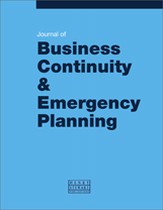Using the disaster crunch/release model in building organisational resilience
Abstract
Systems or process models aim to simplify a specific problem by isolating the major influencing factors (although at the expense of other factors). By so doing, they aim to enable their users to predict how systems or processes will behave as those pre-selected criteria alter. They are of course limited, as they do not fully represent reality, and their effectiveness degrades as social phenomena are included; nonetheless, they are helpful in guiding understanding. The field of organisational resilience already boasts certain models, such as the cultural web and the 7Cs of crisis management. This paper, however, argues that other models from related fields can aid resilience planning. In particular the paper takes the crunch/release model for disaster management, and explores how a model developed to assist with the management of major emergencies in nation states can help organisations to build resilience. The paper will describe the model and then adapt it to cater for the tangible, intangible and social or cohesive factors of organisational resilience. By using this model to understand these resilience components, organisations can gain clarity on what ultimately determines their own resilience levels and therefore how best to enhance that resilience.
The full article is available to subscribers to the journal.
Author's Biography
Alan Elwood is a Director with Risk and Resilience Ltd, providing guidance on risk management, crisis management and business continuity to both public and private sector organisations, including blue-chip companies and those operating in high-risk environments. He has years of experience planning for and responding to crises and emergencies at the strategic, tactical and operational levels in demanding environments. He has also been involved the drafting of some of the leading guidance in these areas. He is a Fellow of the Business Continuity Institute and the Institute of Civil Protection Emergency Management, and a Member of the Emergency Planning Society.
Citation
Elwood, Alan (2009, May 1). Using the disaster crunch/release model in building organisational resilience. In the Journal of Business Continuity & Emergency Planning, Volume 3, Issue 3. https://doi.org/10.69554/OEPY7793.Publications LLP
